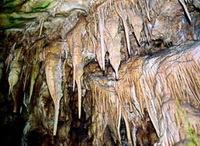Resavska Cave
Resavska Cave is situated in the area of Gornja Resava, about 20km away from the town of Despotovac.  It’s in a limestone hill known as Babina Glava (grandmother’s head), on the skirts of the lime field of Divljakovac.
It’s in a limestone hill known as Babina Glava (grandmother’s head), on the skirts of the lime field of Divljakovac.
About 800 m of the cave is open for visitors. There is a concrete path leading through many of the two-leveled halls, connected by steep metal stairs.
Numerous amazingly shaped cave ornaments were given fantastic names: "Elephant Foot", "Hangin Sheep", "Crystal Palace", "Thirst for Love" etc.
{tab=history}
History of Resavska Cave
Resavska Cave is one of the geologically oldest caves in Serbia. It is almost 80 million years old, while some of the cave ornaments have been there for about 45 million years. The cave was created before the Ice Age, and its creation was caused by chemical and mechanical erosion of limestone by a sinking river.
The cave has always been well known among the local shepherds, who used it as a shelter during storms, both for the sheep and for themselves. One of the shepherds revealed the cave to the mountaineers from Svilajnac, in 1962. It was then examined in detail by speleologists from Novi Sad, led by Dr. Jovan Petrovic.
It took 10 years to prepare a part of the Resava Cave for visitors. It was opened on April 22 1972, and has ever since been one of the main tourist attractions of the region.
{tab=getting there}
Getting to Resavska Cave
From Despotovac, take a bus, hitchhike or walk (15 km = approx. 3 hours on foot) to the village of Strmosten.
From the village, you have another 3 km away to the motel "Lisine", and another 10 minutes to the mountain lodge, usually closed. If you follow the same road and walk past the lodge, in another 20 minutes you will reach Buk Waterfall, one of the biggest in Serbia. From there you need approx. one more hour to reach the entrance to the Resavska Cave. The road is good and there are plenty of signs pointing to the cave.
{tab=things to see}What to see in Resavska Cave?
From the very entrance, you will notice rich cave ornamentation in three colours, depending on the kind of mineral over which the water flows. Most of the cave is either yellow (clay), white (calcium crystal) or red (iron oxyde).
Only organized visits with a guide are allowed, on which two cave galleries can be seen. The upper gallery consists of four chambers. The first one is the Pillar Chamber, named after yelowish limestone pillars connecting the ground with the ceiling. Next is the Beehive Chamber, where, on your left, you'll notice three hive-shaped stalagmites.
The Canyon Canal connects the second and the third chamber. The third one carries the name "History Forecourt", because some tools of the prehistoric men, together with the hearth, stone axes, spear tips and a scull of the silver fox were found here.
Through some short tunnels you will reach the path leading to the Fossilised Waterfalls, where two natural sculptures of white crystal, called Grandmother and Grandfather, are located. In the fourth, Crystal Hall, the ornaments under the names Hanging Sheep, Elephant’s Foot etc. can be seen, as well as the indention closed by stalactites and stalagmites, known as The Prison or The Cage.
From there cockle stairs will take you to the fifth chamber- Concert or Sculpture Hall with a 20 m high and 13 m wide pillar in the center, which is probably the most attractive part od the cave. There is also a 12 m pillar called Mother with a Child made of red crystal, except for the supposed "faces", which are white crystal.
The sixth, Boban’s Chamber is separated from the fifth by the wall called the Skull Tower, with figures resembling the human skulls. Between the sixth and the seventh chamber there is a gallery called "Cafeteria" with a waterfall of white crystal. From there you enter the seventh chamber, known as the Coral Canal, and the eight, "Muddy Chamber". There is a stalactite and a stalagmite growing towards each other, called the Thirst for Love or a Date in a Thousand Years, because it is assumed that that much time is needed for this two formations to touch.
A lot of the moss and lichen can be found in the cave, as well as plenty of bats, starting right after the entrance.
{/tabs}

